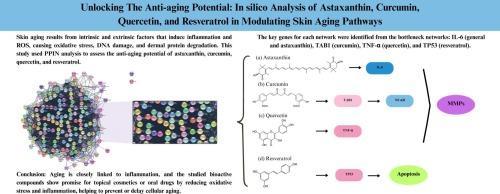解锁抗衰老潜力:虾青素、姜黄素、槲皮素和白藜芦醇在调节皮肤衰老途径中的硅分析
IF 3.1
4区 生物学
Q2 BIOLOGY
引用次数: 0
摘要
多项研究已将衰老与炎症反应的结果联系起来。因此,有一个公认的需要药妆品,调节炎症途径,以防止和治疗衰老。从这个意义上说,我们选择了四种具有抗炎/抗氧化特性的生物活性化合物。因此,本研究旨在评估生物活性化合物虾青素、姜黄素、槲皮素和白藜芦醇是否有效地治疗皮肤衰老,使用硅分析。利用Cytoscape插件生成与皮肤老化和生物活性化合物虾青素、姜黄素、槲皮素和白藜芦醇相关的蛋白-蛋白相互作用网络(PPINs),分析回收蛋白的功能富集。在这些主要网络的基础上,又产生了集群和瓶颈网络。最初,生成了5个主要PPINs。从从主要网络中恢复的集群中,从一般网络中选择3个,从特定网络中选择11个。通过对这些簇的功能富集,确定了氧化应激反应的生物学过程。血液和造血组织、血管和免疫系统异常表型也被观察到,同时炎症反应增加。此外,还注意到与白细胞介素信号传导和活性氧解毒相关的Reactome途径。最后,从瓶颈网络中鉴定出每个网络的关键基因:IL-6(一般和虾青素)、TAB1(姜黄素)、TNF-α(槲皮素)和TP53(白藜芦醇)。基于这项研究,分析的生物活性化合物表明,化妆品中可能含有潜在的功效,因为它们能够减少过度的氧化应激和炎症过程,从而防止细胞衰老。本文章由计算机程序翻译,如有差异,请以英文原文为准。

Unlocking the anti-aging potential: In silico analysis of astaxanthin, curcumin, quercetin, and resveratrol in modulating skin aging pathways
Multiple studies have linked aging to a result of the inflammatory response. Thus, there is a recognized need for cosmeceuticals that modulate inflammation pathways to prevent and treat aging. In this sense, four bioactive compounds were selected for their documented anti-inflammatory/antioxidant properties. Therefore, this study aimed to evaluate whether the bioactive compounds astaxanthin, curcumin, quercetin, and resveratrol are effective in treating the effects of skin aging, using in silico analyses. Protein-protein interaction networks (PPINs) related to skin aging and the bioactive compounds astaxanthin, curcumin, quercetin, and resveratrol were generated using the Cytoscape plug-in to analyze the functional enrichment of recovered proteins. From these main networks, clusters and bottleneck networks were generated. Initially, 5 main PPINs were generated. From the clusters recovered from the main networks, 3 were selected from the general network and 11 from the specific networks. Through functional enrichment of the clusters, the biological process of response to oxidative stress was identified. Blood and blood-forming tissue, vascular, and immune system abnormality phenotypes were also observed, along with an increase in inflammatory response. Additionally, Reactome pathways related to interleukin signaling and detoxification of reactive oxygen species were noted. Finally, the key genes for each network were identified from the bottleneck networks: IL-6 (general and astaxanthin), TAB1 (curcumin), TNF-α (quercetin), and TP53 (resveratrol). Based on this research, the analyzed bioactive compounds suggest potential efficacy to be included in cosmetic products, as they are capable of reducing excessive oxidative stress and inflammatory processes, consequently preventing cellular aging.
求助全文
通过发布文献求助,成功后即可免费获取论文全文。
去求助
来源期刊

Computational Biology and Chemistry
生物-计算机:跨学科应用
CiteScore
6.10
自引率
3.20%
发文量
142
审稿时长
24 days
期刊介绍:
Computational Biology and Chemistry publishes original research papers and review articles in all areas of computational life sciences. High quality research contributions with a major computational component in the areas of nucleic acid and protein sequence research, molecular evolution, molecular genetics (functional genomics and proteomics), theory and practice of either biology-specific or chemical-biology-specific modeling, and structural biology of nucleic acids and proteins are particularly welcome. Exceptionally high quality research work in bioinformatics, systems biology, ecology, computational pharmacology, metabolism, biomedical engineering, epidemiology, and statistical genetics will also be considered.
Given their inherent uncertainty, protein modeling and molecular docking studies should be thoroughly validated. In the absence of experimental results for validation, the use of molecular dynamics simulations along with detailed free energy calculations, for example, should be used as complementary techniques to support the major conclusions. Submissions of premature modeling exercises without additional biological insights will not be considered.
Review articles will generally be commissioned by the editors and should not be submitted to the journal without explicit invitation. However prospective authors are welcome to send a brief (one to three pages) synopsis, which will be evaluated by the editors.
 求助内容:
求助内容: 应助结果提醒方式:
应助结果提醒方式:


